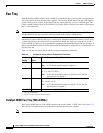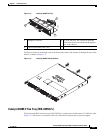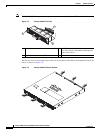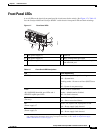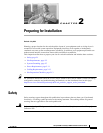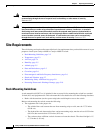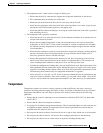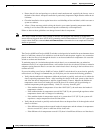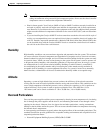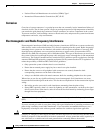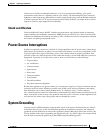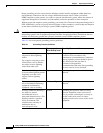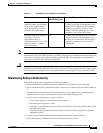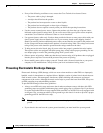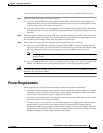
2-4
Catalyst 4948E and Catalyst 4948E-F Switch Installation Guide
OL-21561-02
Chapter 2 Preparing for Installation
Site Requirements
• Ensure that all slots and openings on a chassis remain unobstructed, especially the fan tray vent at
the back of the chassis. Adequate ventilation is particularly important at high altitudes where the air
is thinner.
• Clean the installation site at regular intervals to avoid buildup of dust and debris, which can cause a
system to overheat.
• Allow a 2-hour warm-up period to bring the chassis up to normal operating temperature before
turning it on for chassis that have been exposed to abnormally cold temperatures.
Failure to observe these guidelines can damage internal chassis components.
Note The Catalyst 4948E and the Catalyst 4948E-F switches are equipped with internal air temperature
sensors that are triggered above 104°F (40°C) generating a minor alarm and above 131°F (55°C) generating
a major alarm. Enter the command show environment status to determine the exact temperature when the
alarms are generated.
Air Flow
The Catalyst 4948E and Catalyst 4948E-F switches are designed to be installed in an environment where
there is a sufficient volume of air available to cool the chassis and the power supplies. Any constraints
placed on the free flow of air through the chassis or an elevated ambient air temperature can cause the
switch to overheat and shut down.
To maintain proper air circulation through the switch chassis, we recommend that you maintain a
minimum 6-inch (15
cm) separation between a wall and the chassis hot air exhaust. Failure to maintain
adequate spacing between chassis can cause the switch chassis that is drawing in the hot exhaust air to
overheat and fail.
If you are installing your Catalyst 4948E or Catalyst 4948E-F switch chassis in an enclosed or partially
enclosed rack, we strongly recommend that you verify that your site meets the following guidelines:
• Verify that the ambient air temperature within the enclosed or partially enclosed rack is within the
chassis operating temperature limits. After installing the chassis in the rack, power up the chassis
and allow the chassis temperature to stabilize (approximately 2 hours). Measure the ambient air
temperature at the chassis air intake grill and at the chassis air exhaust grill by positioning an
external temperature probe approximately 1
inch (2.5 cm) away from the grills.
–
If the ambient intake air temperature is less than 104°F (40°C), the rack meets the intake air
temperature criterion.
–
If the ambient intake air temperature exceeds 104°F (40°C), the system might experience minor
temperature alarms and is in danger of overheating.
–
If the ambient intake air temperature equals or is greater than 131°F (55°C), the system will
experience a major temperature alarm and shut down.
• Verify that the enclosed or partially enclosed rack allows an adequate flow of air through the switch
chassis as follows:
–
If the difference between the measured intake air temperature and the exhaust air temperature
does not exceed 10°C, there is sufficient airflow in the rack.
–
If the difference in air temperature exceeds 10°C, there is insufficient airflow to cool the chassis.



